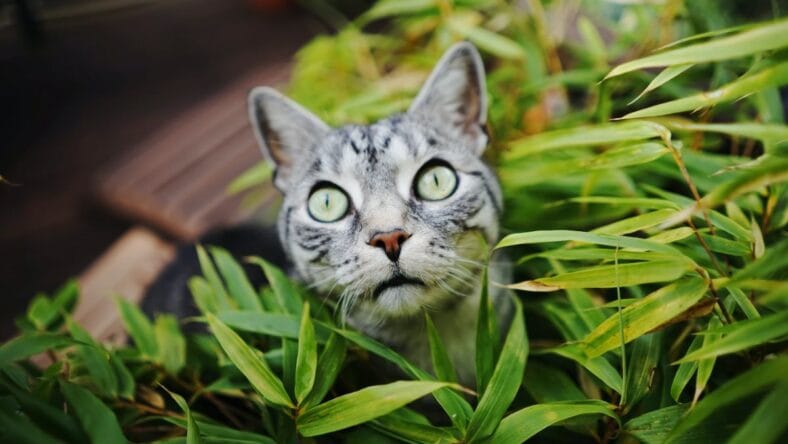
It can be hard being both a pet and plant parent, as there are so many toxins in the world that we have to make sure doesn’t harm them. What can be even more challenging is finding the right plant that can be around your pets, as some are toxic to cats. So, what should you know about cats and ivy?
While there are several plants that should not be paired with dogs or cats, we’ll be focusing on cats specifically, and their relationship with ivy. For those looking to find the best plants to decorate your living space while making sure your cat is comfortable, read more to learn about plant options.
RELATED: How to Start Your Own Herb Garden
Is Ivy Toxic for Cats?

Yes.
English ivy, also known as branching ivy, glacier ivy, needlepoint ivy, sweetheart ivy and California ivy, is toxic to cats according to the American Society for the Prevention of Cruelty to Animals (ASPCA).
Why is it toxic?
The toxic principle in the ivy is called hederagenin, which is a triterpenoid saponin and polyacetylene compounds that causes gastrointestinal disturbances and irritation to the skin and mucous membranes.
This popular indoor plant is an ‘ivy’ genus belonging to the Araliaceae family, consisting of 12-15 evergreen climbing vines that can reach the height of 20-30 meters. In the juvenile stage, the leads are lobed leaves, but once it matures the leaves can change to a more oval shaped.
Flowers and berries can start to develop as well as an adult. The foliage is more toxic to cats than the berries, however.
What are the Signs of Ivy Poisoning?

The ASPCA says that some clinical signs for cats having ivy poisoning is vomiting, abdominal pain, hypersalivation, diarrhea, and loss of appetite. Some other signs include difficulty breathing, lethargy, and blistering, redness or swelling.
More severe cases can cause life-threatening issues, such as seizures, liver failure or even death. Make sure that you are keeping your home safe from any toxins to your furry friends.
How to Treat Ivy Poisoning
If you plant shows any sign of ivy poisoning, go to a veterinary for care. If there are only mild signs, you can offer your cat something to drink like milk. If vomiting or loss of appetite are developing, please seek medical attention.
Other ways to try and treat your cats at home if there are no live threatening symptoms is by bathing them in oatmeal shampoo that is pet friendly. Oatmeal with help soothe the skin to help the irritated skin and hopefully prevent them from itching. Make sure to rinse the affected area for at least 10 minutes.
If you think that your cat may have ingested the plant, use activated charcoal to have your pet vomit. While it can be uncomfortable to do so, making sure everything is out of their system is much better in the long run, as leaving the contents in their stomach cause worse problems.
However, please make sure to watch their symptoms. If things get worse, contact a veterinarian to help your pet get some comfort and relief.
READ MORE: Aesthetic Plants to Glam Up Your Home
What About Other Plants?
There are several plants that could be toxic to your pet, so always make sure you’re doing thorough research before bringing home a new plant. Some more common household plants that could cause issues with your cat include the following.
Avoid Monstera Plants

A popular and trendy plant, the Monstera plants, are actually toxic to your furry friends. Like cats and ivy, there is a toxin in them that is not safe to ingest or touch.
Monstera plants contain calcium oxalate crystals, which if ingested, can irritate the throat and stomach. The irritation can cause pain and vomiting. It can also cause your cat’s mouth and esophagus to swell, resulting in difficulty eating and may even be life threatening.
While some owners do have Monstera’s in their home while owning cats, it’s not recommended and should be avoided.
Absolutely No Lilies
Most lilies, specifically in the “true lily” and “daylily” family are extremely dangerous for cats as the entire plant, including the stem, leaves, flowers, pollen and even the water in the vase, are toxic. Probably more toxic than cats and ivy.
These plants can even be potentially fatal to cats, which means you should avoid having any lilies inside your home to ensure the utmost safety of your furry friend.
They are so toxic that if cats end up just biting into a leaf, licking the pollen from their paws, or drinking the water from the case, it can cause severe kidney failure. The reason for this is a chemical compound called oxalate.
While most lilies can affect the kidneys, some lilies, like lily-of-the-valley and flame lily, can affect the heart and cause abnormal rhythms. Even inhaling the pollen can cause severe damage. Lilies should be nowhere near a cat at any time.
For a short list of other plants to avoid, read below:
- Tulip
- Chrysanthemum
- Amaryllis
- Hyacinth
- Aloe
CHECK OUT: Best Dog Toys for Heavy Chewers That Won’t Get Immediately Destroyed
Try the Swedish Ivy Instead

While cats and ivy can be a horrible mix, not all ivy is toxic. There are some ivy plants that make the perfect house plant while being safe for cats. One such plant is the Swedish Ivy, which is a green foliage plant with rounded leaves that are slightly bluish purple.
This gorgeous plant is a must for any home that wants a pop of color. It’s beautiful, non-toxic, and is pretty easy to care for. The ivy usually has either a golden or bright white center and evergreen edges, which is a beautiful decorative piece for any workspace.
Spider Plants Are the Perfect Choice
One plant that is not toxic to cats are Spider Plants, which are great for being a natural air purifier. They’re also great as they don’t require a lot of work. The ribbon-like fronds are perfectly safe for your cats, and you can even plant more by plucking the baby fronds and replanting to great several ones around your home.
Of course, even with a non-toxic plant, it’s not ideal for cats to consume a great deal of them. Some cats that chew and eat a bunch of the leaves can result in vomiting, so make sure to keep an eye on your animals around your plants.
For more options for safe plants, read below:
- Hibiscus
- Pansies
- Petunia
- Roses
- Valerian
- Zinnia
- Sunflowers
In Conclusion
While plants will always be at risk when entering a home with a pet, it’s safer to pick up non-toxic plants to ensure your pet’s ultimate safety. While cats and ivy are dangerous together, there are several other choices that would work a lot better, and even keep your home looking beautiful without putting your pet in harm’s way.
So, for those that want to start introducing yourself to being a pet parents, don’t worry, as you can still have the best of both worlds without stressing so much about causing any damage. Just make sure you research ahead before purchasing. One of the best resources that you can use is the ASPCA website that breaks down if plants are toxic to various animals.

10 Best Dog Breeds for Kids and Families
Explore More About:Home & Garden